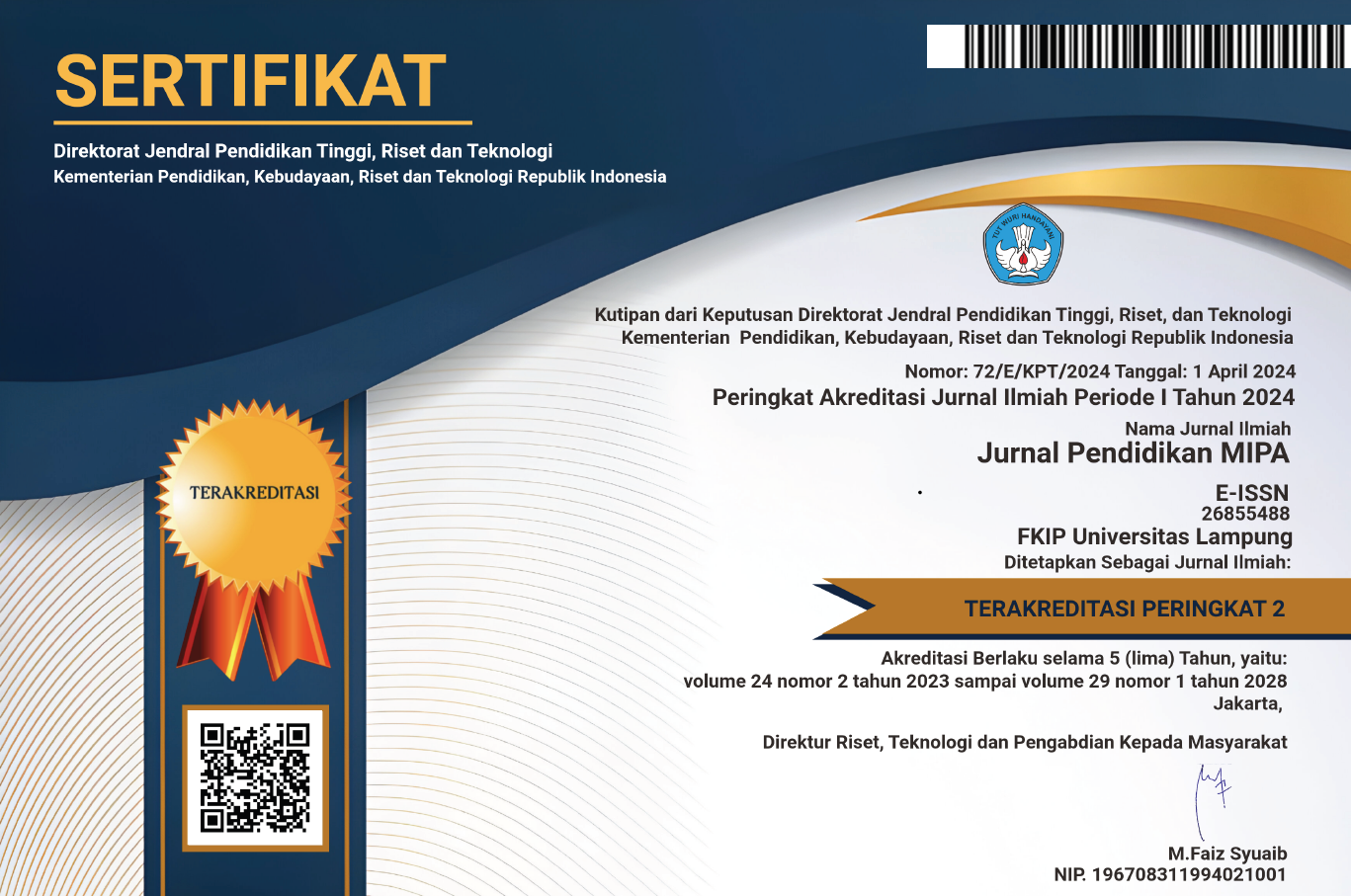Chemistry Teachers’ Perspectives to Enchancing Representational Competence in Learning Thermochemistry
 Country:
Country:
(1) Universitas Negeri Malang, Indonesia
(2) Universitas Negeri Malang, Indonesia
(3) Universitas Negeri Malang, Indonesia
| Metrics→ |
| Indexing Site→ |
Copyright (c) 2024 Ima Rosyida, Hayuni Retno Widarti, Yahmin Yahmin
Abstract
Representational competence is very essential for students because it is associated with the students' ability to use, interpret, translate and integrate chemical representations to understand chemical concepts properly. In this case, implementation of the various representations utilization is required in learning Thermochemistry to improve students' representational competence to fully understand Thermochemistry. Therefore, this study aims to analyze teachers' perceptions towards the understanding and implementation of chemical representations in chemistry learning to improve students' representational competence in thermochemistry. This research is a descriptive quantitative research conducted using survey method that involved 30 chemistry teachers. The sample in this study was taken by purposive random sampling at public and private high schools in East Java. The data were collected through a questionnaire using google form application. According to the results of the study 63.3% of teachers still have difficulty in teaching students the concept of thermochemistry using submicroscopic representations. The majority of teachers only use symbolic representations, even though the other two representations are very important. Although 77% of teachers have understood chemical representations, in teaching and measuring concept understanding, teachers have not integrated chemical representations. This is due to their lack of self-awareness about the importance of using various representations in improving students’ representational competence. Thus, training on representations is necessary in improving teachers’ understanding on chemical representations. The findings of the study stated that teachers’ understanding of representation and teachers’ experience in participating in the trainings contributed to the effectiveness of the implementation of various chemical representations utilization to improve students’ representational competence on the concept of thermochemistry.
Keywords: representational competence, chemical representation, and thermochemistry.
DOI: http://dx.doi.org/10.23960/jpmipa/v25i3.pp1559-1576
References
Ainsworth, S. (2008). The educational value of multiple-representastions when learning complex scientific concepts. In J.K Gilbert, M. Reiner, & M. Nakhleh (Eds), Visulialisation: Theory and practice in science education. Doerdrecht: Springer.
Chandrasegaran, A. L., Treagust, D. F., & Mocerino, M. (2007). The development of a two-tier multiple-choice diagnostic instrument for evaluating secondary school students ’ ability.Chemistry Education Research and Practice, 8(3), 293–307.
Chang, R. (2010). Chemistry 10th Edition (10th ed). New York: Mc Graw Hill.
Chittleborough, G., & Treagust, D. F. (2007). The modelling ability of non-major chemistry students and their understanding of the sub-microscopic level. Chemistry Education Research and Practice, 8(3), 274–292.
Creswell. (2012). Educational research: planning, conducting, and evaluating quantitative and qualitative research (4th edition). Boston: Pearson Education.
Fraenkel, J. R. W. N. E. & H. H. H. (2012). How to design and evaluate research in education (8th ed.). New York: Mc Graw Hill.
Gabel, D. (1998). The complexity of chemistry and implications for teaching. In B. J. Fraser & K. G. Tobin (Eds.), International handbook of science education (pp. 233–248). Dordrecht, The Netherlands: Kluwer Academic Publishers.
Gilbert, J. K., & Treagust, D. F. (2009). Model and modeling in science education, multiple representations in chemical education. Dordrecht: Springer Science.
Gkitzia, V., Salta, K., & Tzougraki, C. (2019). Students’ competence in translating between different types of chemical representations. Chemistry Education Research and Practice, 21(1), 307–330.
Hilton, A., & Nichols, K. (2011). Representational classroom practices that contribute to students’ conceptual and representational understanding of chemical bonding. International Journal of Science Education, 33(16), 2215–2246. https://doi.org/10.1080/09500693.2010.543438
Johnstone, A. H. (1993). The development of chemistry teaching: a changing response to canging deman. Journal of Chemical Education, 70(9), 701–705.
Kozma, R. & Russell, J. (2005). Students Becoming Chemists : Developing Representational Competence In J. Gilbert (Ed), Visualization in science education. In J. K. Gilbert (Ed.), Visualization in Science Education (pp. 121–145). Deodrecht: Springer.
Popova, M., & Jones, T. (2021). Chemistry instructors’ intentions toward developing, teaching, and assessing student representational competence skills. Chemistry Education Research and Practice, 22(3), 733–748.
Silberberg, M. S.(2013). Principles of general chemistry (Third). New York: McGraw-Hill.
Sim, J. H., Gnanamalar, E., & Daniel, S. (2014). Representational competence in chemistry : A comparison between students with different levels of understanding of basic chemical concepts and chemical representations A comparison between students with different. Cougent Education, 991180(1), 1–17.
Talanquer, V. (2011). Macro , Submicro , and Symbolic : The many faces of the chemistry “ triplet ”. International Journal of Science Education, 33, No. 2, 179–195.
Tuysuz, M. et. al. (2011). Pre-Service chemistry teachers’ understanding of phase changes and dissolution at macroscopic, symbolic, and microscopic levels. Procedia - Social And Behavioral Sciences, 15, 452–455.
Wren, D. & Jack, B. (2013). Gathering evidence for validity during the design, development, and qualitative evaluation of thermochemistry concept inventory items. Journal of Chemical Education, 90, 1590-1601.
Refbacks
- There are currently no refbacks.

This work is licensed under a Creative Commons Attribution-ShareAlike 4.0 International License.

The copyright is reserved to The Jurnal Pendidikan MIPA that is licensed under a Creative Commons Attribution-ShareAlike 4.0 International License.


